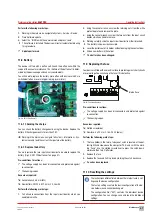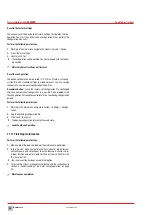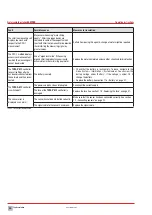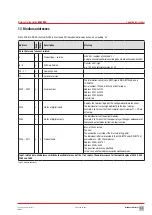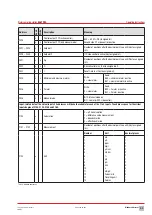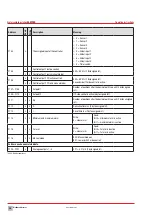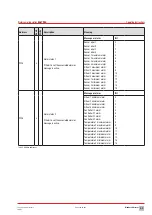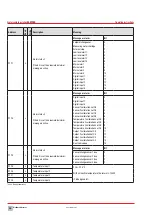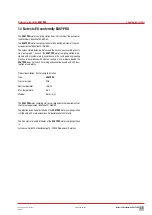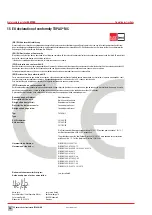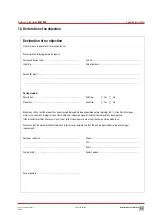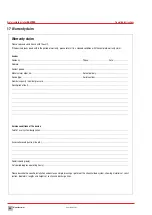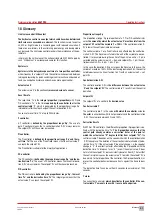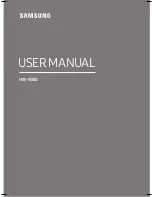
Glossary
61
Subject to technical changes.
200114
BA-42820-02-V03
Water sampling station
EASYPRO
Operating instructions
18 Glossary
Limit value control/DIN contact
The limit value control is an output which switches when determined
limit values are exceeded or undercut.
This function is used to control
an ECO or Night mode in a swimming pool with reduced circulation. If
there are no swimmers in the swimming pool, energy and dosing media
can be saved. The limit value control monitors the maintenance of the pa-
rameters.
In Germany, the limit values of the national standard DIN 19643 apply. As
such, “DIN contact“ is a widespread name for this function.
Hysteresis
Hysteresis is the delayed response time of a two position controller
,
when it reaches the “setpoint Y” and the control switches quickly between
raising and lowering. As quick switching or control can have undesired ef-
fects, you can define hysteresis and achieve a more equal control.
Actual value X
The actual value ‘X’ is the continually
measured value of a sensor
.
Reset time Tn
The reset time ‘Tn’ is the
integral proportion (I proportion)
with PI and
PID controllers. ‘Tn’ is the time
required by the controller to alter the
control variable ‘Y’
, which is generated by the proportional range ‘Xp’
immediately after the step change of the control deviation ‘X-W‘.
You can set a reset time ‘Tn’ of up to 200 minutes.
P controller
A P controller is
defined by the proportional range ‘Xp’
. The use of a
pure P controller means that a control deviation ‘X-W’ always remains.
The setpoint ‘W’ will thus never be reached.
PI controller
The PI controller is
defined by the proportional range ‘Xp’ and the re-
set time ‘Tn’
. The use of the PI controller means that the actual value ‘X’
can reach the setpoint ‘W’.
The PI controller is suitable for the majority of applications.
PD-controller
The PD controller is
defined by the proportional range ‘Xp’ and the de-
rivative time ‘Tv’
. The use of a PD controller means that a control devia-
tion ‘X-W’ always remains. The setpoint ‘W’ will thus never be reached.
PID controller
The PID controller is
defined by the proportional range ‘Xp’, the reset
time ‘Tn’ and the derivative time ‘Tv’
. The integral gain means that the
actual value ‘X’ can reach the setpoint ‘W’.
Proportional range Xp
The proportional range ‘Xp’ (p proportion) of a P, PI or PID controller indi-
cates
the amount by which the actual value ‘X’ must deviate from the
setpoint ‘W’ so that the variable Y = 100 %
. If the control deviation ‘X-
W’ is lower, the control variable is also lower.
The control variable ‘Y’ of a P controller is only affected by the control de-
viation ‘X-W’. The Xp value is stated in the unit of the variable to be con-
trolled. If for example, during the control of the pH value, an Xp = 2 pH is
selected and the actual value is X = 9 pH and setpoint W = 7 pH, the con-
trol deviation is X-W = 9 pH – 7 pH = 2 pH.
In this case, the deviation X-W is as large as the Xp value. In this case, the
variable Y would be 100 %. With a decreasing deviation X-W, the control
variable decreases in a linear fashion to 0 % with an actual value X = set-
point W.
Control deviation X-W
The control deviation X-W is
the difference between the actual value
‘X’ and the setpoint ‘W’
. The control variable ‘Y’ results from the control
deviation.
Setpoint W
The setpoint ‘W’ of a control is the
desired value
.
Control variable Y
The control variable ‘Y’ is the value
with which the controller
actuates
the actor
in accordance with its set parameters and the control deviation
‘X-W’. The value lies between 0 % and 100 %.
Derivative time Tv
With PD or PID controllers, the differential proportion (D proportion) is de-
fined with the derivative time ‘Tv’.
The D proportion ensures that the
control path already contains a correction factor at the point at
which the actual value "X" begins to differ from setpoint "W".
The
control variable ‘Y’ depends on the speed with which the control deviation
‘X-W’ takes place. The duration of the correction is determined by the de-
rivative time ‘Tv’. If the actual value ‘X’ does not change, i.e. the speed of
change is “0”, the correction factor effected by the D proportion with the
derivative time ‘Tv’ drops as far as “0” (even if the actual value ‘X’ does
not match the setpoint ‘W’, but consistently deviates from it). The fact that
the control system causes the actual value ‘X’ to match the setpoint ‘W’ is
due mainly to the I proportion of the controller. The D proportion often im-
proves the controller behaviour because it acts against the trend to devi-
ate.
The derivative time Tv can be set from 0 seconds to a maximum of 1200
seconds.
Y alarm
You can activate an alarm
which deactivates the controller if the con-
trol variable ‘Y’ amounts to over 95 % over a defined period.

